Construction Information: Drawing, Detailing, Specification
VerifiedAdded on 2023/01/17
|8
|1914
|22
AI Summary
This document provides information about different types of construction information and how it is used in diverse projects. It discusses the importance of accurate and timely communication in the construction process. The document also includes details about drawing, detailing, and specification in construction.
Contribute Materials
Your contribution can guide someone’s learning journey. Share your
documents today.
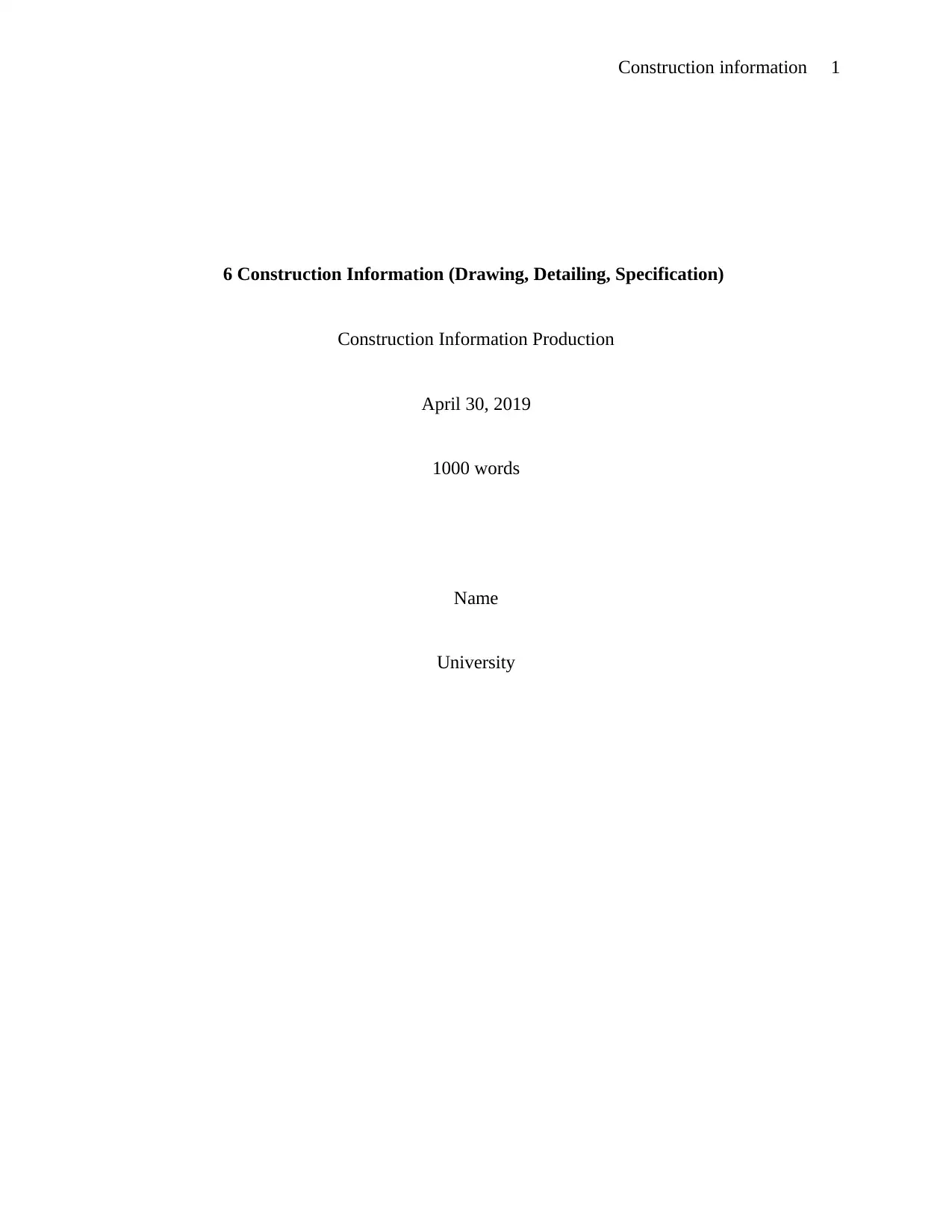
Construction information 1
6 Construction Information (Drawing, Detailing, Specification)
Construction Information Production
April 30, 2019
1000 words
Name
University
6 Construction Information (Drawing, Detailing, Specification)
Construction Information Production
April 30, 2019
1000 words
Name
University
Secure Best Marks with AI Grader
Need help grading? Try our AI Grader for instant feedback on your assignments.
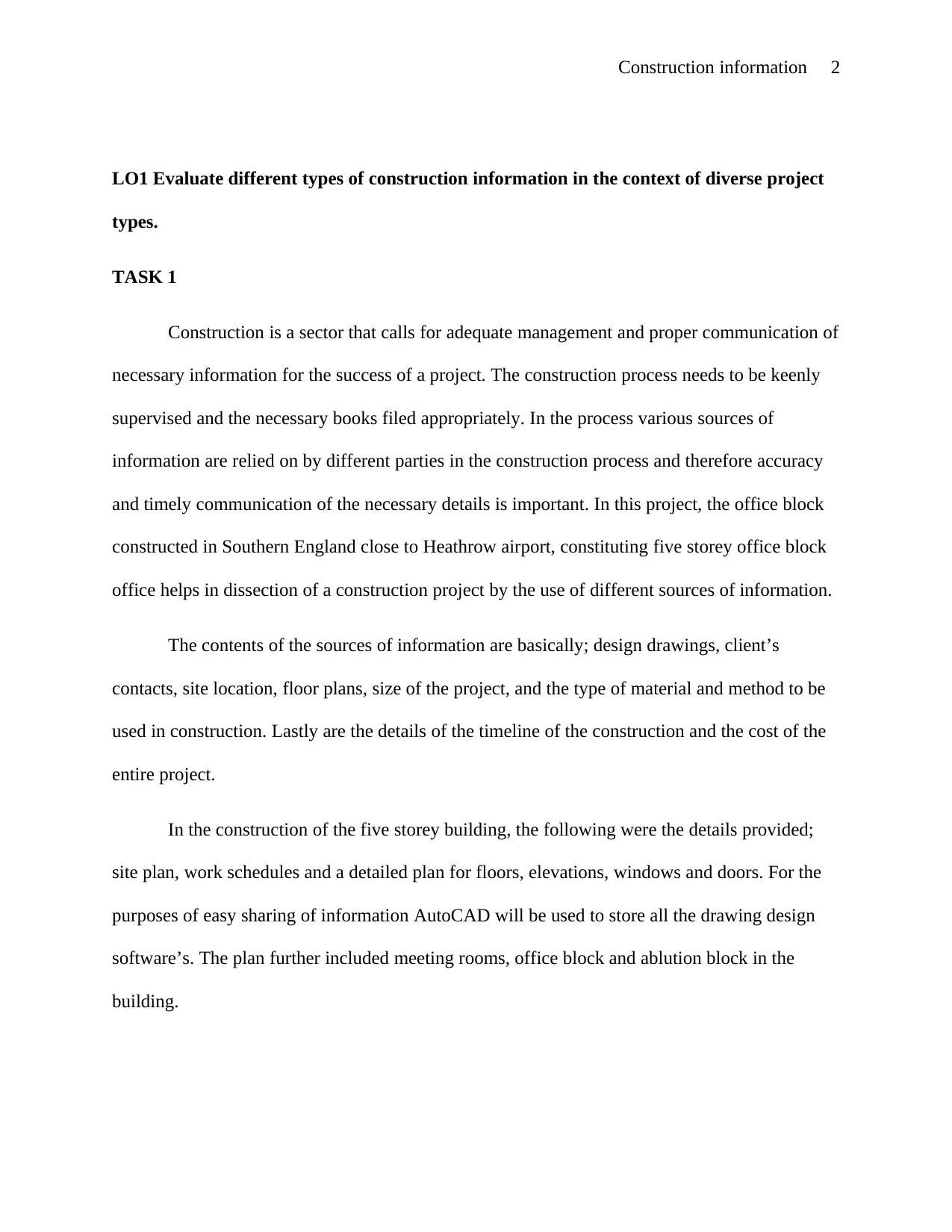
Construction information 2
LO1 Evaluate different types of construction information in the context of diverse project
types.
TASK 1
Construction is a sector that calls for adequate management and proper communication of
necessary information for the success of a project. The construction process needs to be keenly
supervised and the necessary books filed appropriately. In the process various sources of
information are relied on by different parties in the construction process and therefore accuracy
and timely communication of the necessary details is important. In this project, the office block
constructed in Southern England close to Heathrow airport, constituting five storey office block
office helps in dissection of a construction project by the use of different sources of information.
The contents of the sources of information are basically; design drawings, client’s
contacts, site location, floor plans, size of the project, and the type of material and method to be
used in construction. Lastly are the details of the timeline of the construction and the cost of the
entire project.
In the construction of the five storey building, the following were the details provided;
site plan, work schedules and a detailed plan for floors, elevations, windows and doors. For the
purposes of easy sharing of information AutoCAD will be used to store all the drawing design
software’s. The plan further included meeting rooms, office block and ablution block in the
building.
LO1 Evaluate different types of construction information in the context of diverse project
types.
TASK 1
Construction is a sector that calls for adequate management and proper communication of
necessary information for the success of a project. The construction process needs to be keenly
supervised and the necessary books filed appropriately. In the process various sources of
information are relied on by different parties in the construction process and therefore accuracy
and timely communication of the necessary details is important. In this project, the office block
constructed in Southern England close to Heathrow airport, constituting five storey office block
office helps in dissection of a construction project by the use of different sources of information.
The contents of the sources of information are basically; design drawings, client’s
contacts, site location, floor plans, size of the project, and the type of material and method to be
used in construction. Lastly are the details of the timeline of the construction and the cost of the
entire project.
In the construction of the five storey building, the following were the details provided;
site plan, work schedules and a detailed plan for floors, elevations, windows and doors. For the
purposes of easy sharing of information AutoCAD will be used to store all the drawing design
software’s. The plan further included meeting rooms, office block and ablution block in the
building.
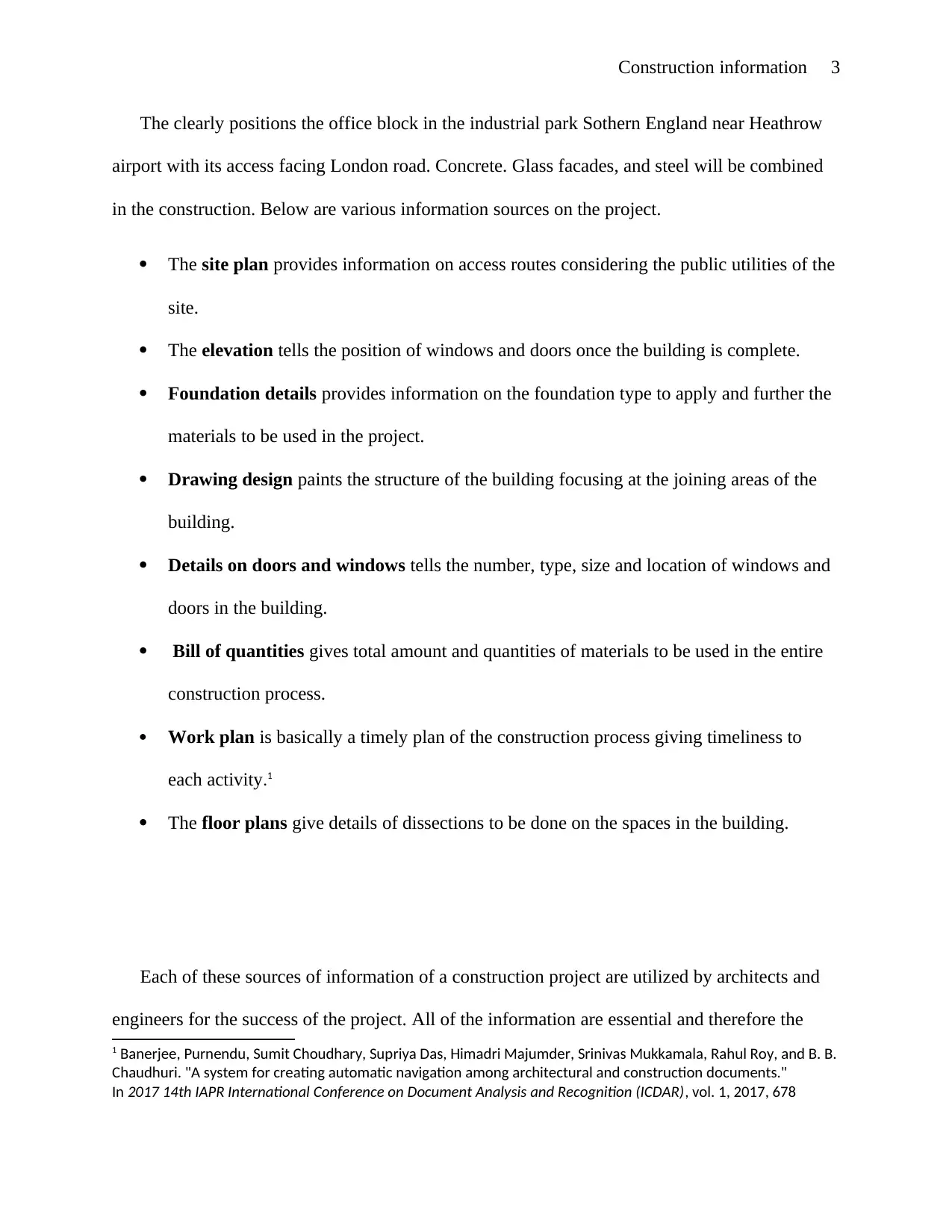
Construction information 3
The clearly positions the office block in the industrial park Sothern England near Heathrow
airport with its access facing London road. Concrete. Glass facades, and steel will be combined
in the construction. Below are various information sources on the project.
The site plan provides information on access routes considering the public utilities of the
site.
The elevation tells the position of windows and doors once the building is complete.
Foundation details provides information on the foundation type to apply and further the
materials to be used in the project.
Drawing design paints the structure of the building focusing at the joining areas of the
building.
Details on doors and windows tells the number, type, size and location of windows and
doors in the building.
Bill of quantities gives total amount and quantities of materials to be used in the entire
construction process.
Work plan is basically a timely plan of the construction process giving timeliness to
each activity.1
The floor plans give details of dissections to be done on the spaces in the building.
Each of these sources of information of a construction project are utilized by architects and
engineers for the success of the project. All of the information are essential and therefore the
1 Banerjee, Purnendu, Sumit Choudhary, Supriya Das, Himadri Majumder, Srinivas Mukkamala, Rahul Roy, and B. B.
Chaudhuri. "A system for creating automatic navigation among architectural and construction documents."
In 2017 14th IAPR International Conference on Document Analysis and Recognition (ICDAR), vol. 1, 2017, 678
The clearly positions the office block in the industrial park Sothern England near Heathrow
airport with its access facing London road. Concrete. Glass facades, and steel will be combined
in the construction. Below are various information sources on the project.
The site plan provides information on access routes considering the public utilities of the
site.
The elevation tells the position of windows and doors once the building is complete.
Foundation details provides information on the foundation type to apply and further the
materials to be used in the project.
Drawing design paints the structure of the building focusing at the joining areas of the
building.
Details on doors and windows tells the number, type, size and location of windows and
doors in the building.
Bill of quantities gives total amount and quantities of materials to be used in the entire
construction process.
Work plan is basically a timely plan of the construction process giving timeliness to
each activity.1
The floor plans give details of dissections to be done on the spaces in the building.
Each of these sources of information of a construction project are utilized by architects and
engineers for the success of the project. All of the information are essential and therefore the
1 Banerjee, Purnendu, Sumit Choudhary, Supriya Das, Himadri Majumder, Srinivas Mukkamala, Rahul Roy, and B. B.
Chaudhuri. "A system for creating automatic navigation among architectural and construction documents."
In 2017 14th IAPR International Conference on Document Analysis and Recognition (ICDAR), vol. 1, 2017, 678
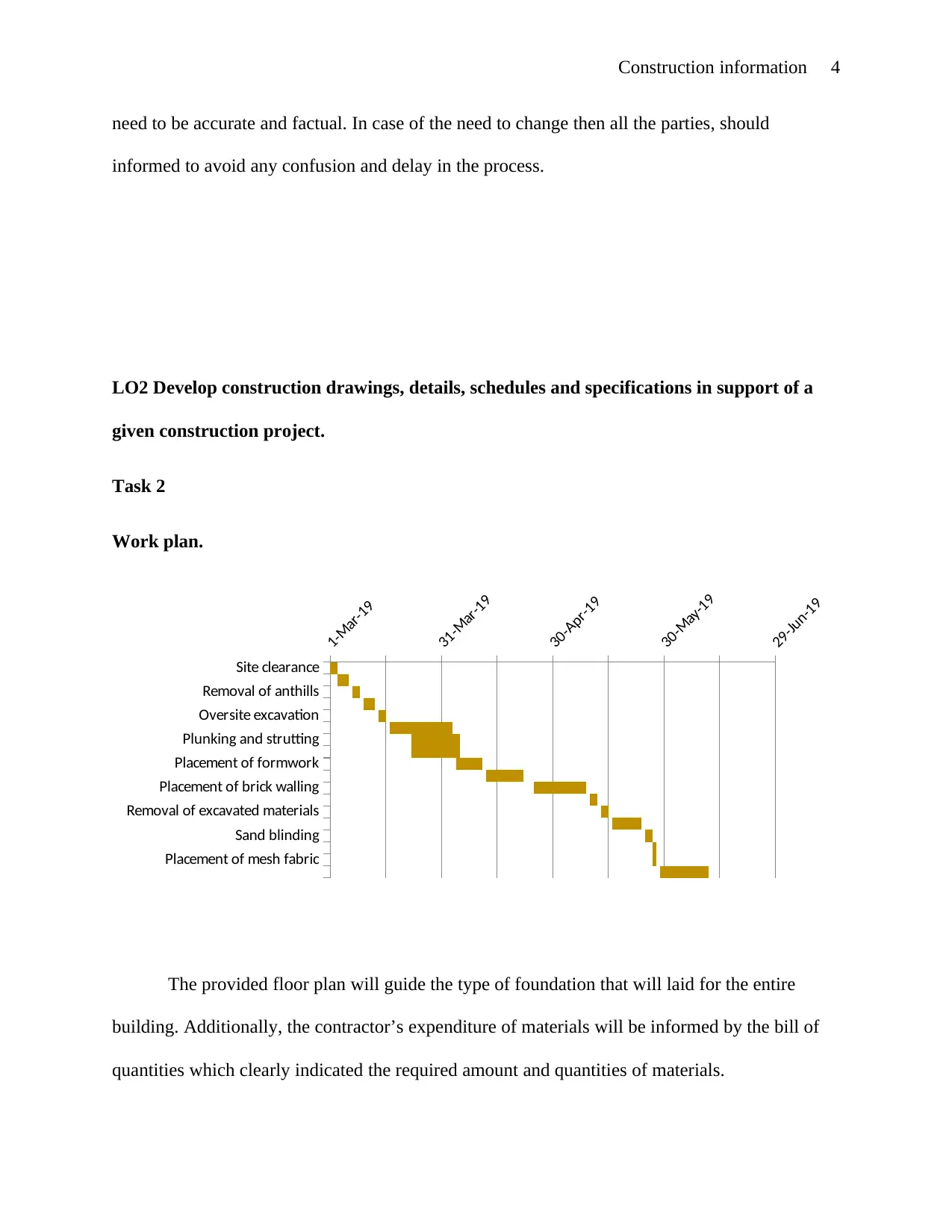
Construction information 4
need to be accurate and factual. In case of the need to change then all the parties, should
informed to avoid any confusion and delay in the process.
LO2 Develop construction drawings, details, schedules and specifications in support of a
given construction project.
Task 2
Work plan.
Site clearance
Removal of anthills
Oversite excavation
Plunking and strutting
Placement of formwork
Placement of brick walling
Removal of excavated materials
Sand blinding
Placement of mesh fabric
1-Mar-19
31-Mar-19
30-Apr-19
30-May-19
29-Jun-19
The provided floor plan will guide the type of foundation that will laid for the entire
building. Additionally, the contractor’s expenditure of materials will be informed by the bill of
quantities which clearly indicated the required amount and quantities of materials.
need to be accurate and factual. In case of the need to change then all the parties, should
informed to avoid any confusion and delay in the process.
LO2 Develop construction drawings, details, schedules and specifications in support of a
given construction project.
Task 2
Work plan.
Site clearance
Removal of anthills
Oversite excavation
Plunking and strutting
Placement of formwork
Placement of brick walling
Removal of excavated materials
Sand blinding
Placement of mesh fabric
1-Mar-19
31-Mar-19
30-Apr-19
30-May-19
29-Jun-19
The provided floor plan will guide the type of foundation that will laid for the entire
building. Additionally, the contractor’s expenditure of materials will be informed by the bill of
quantities which clearly indicated the required amount and quantities of materials.
Secure Best Marks with AI Grader
Need help grading? Try our AI Grader for instant feedback on your assignments.
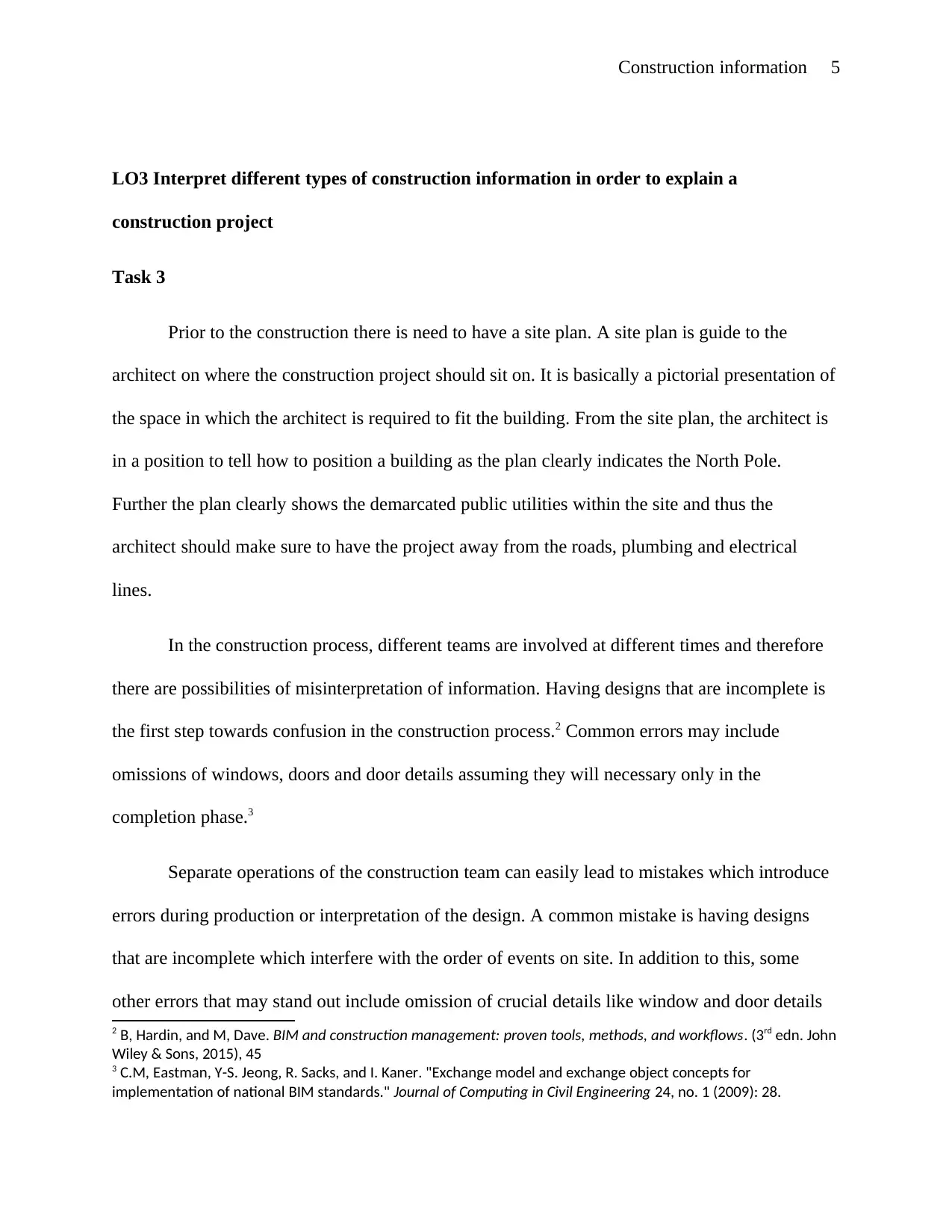
Construction information 5
LO3 Interpret different types of construction information in order to explain a
construction project
Task 3
Prior to the construction there is need to have a site plan. A site plan is guide to the
architect on where the construction project should sit on. It is basically a pictorial presentation of
the space in which the architect is required to fit the building. From the site plan, the architect is
in a position to tell how to position a building as the plan clearly indicates the North Pole.
Further the plan clearly shows the demarcated public utilities within the site and thus the
architect should make sure to have the project away from the roads, plumbing and electrical
lines.
In the construction process, different teams are involved at different times and therefore
there are possibilities of misinterpretation of information. Having designs that are incomplete is
the first step towards confusion in the construction process.2 Common errors may include
omissions of windows, doors and door details assuming they will necessary only in the
completion phase.3
Separate operations of the construction team can easily lead to mistakes which introduce
errors during production or interpretation of the design. A common mistake is having designs
that are incomplete which interfere with the order of events on site. In addition to this, some
other errors that may stand out include omission of crucial details like window and door details
2 B, Hardin, and M, Dave. BIM and construction management: proven tools, methods, and workflows. (3rd edn. John
Wiley & Sons, 2015), 45
3 C.M, Eastman, Y-S. Jeong, R. Sacks, and I. Kaner. "Exchange model and exchange object concepts for
implementation of national BIM standards." Journal of Computing in Civil Engineering 24, no. 1 (2009): 28.
LO3 Interpret different types of construction information in order to explain a
construction project
Task 3
Prior to the construction there is need to have a site plan. A site plan is guide to the
architect on where the construction project should sit on. It is basically a pictorial presentation of
the space in which the architect is required to fit the building. From the site plan, the architect is
in a position to tell how to position a building as the plan clearly indicates the North Pole.
Further the plan clearly shows the demarcated public utilities within the site and thus the
architect should make sure to have the project away from the roads, plumbing and electrical
lines.
In the construction process, different teams are involved at different times and therefore
there are possibilities of misinterpretation of information. Having designs that are incomplete is
the first step towards confusion in the construction process.2 Common errors may include
omissions of windows, doors and door details assuming they will necessary only in the
completion phase.3
Separate operations of the construction team can easily lead to mistakes which introduce
errors during production or interpretation of the design. A common mistake is having designs
that are incomplete which interfere with the order of events on site. In addition to this, some
other errors that may stand out include omission of crucial details like window and door details
2 B, Hardin, and M, Dave. BIM and construction management: proven tools, methods, and workflows. (3rd edn. John
Wiley & Sons, 2015), 45
3 C.M, Eastman, Y-S. Jeong, R. Sacks, and I. Kaner. "Exchange model and exchange object concepts for
implementation of national BIM standards." Journal of Computing in Civil Engineering 24, no. 1 (2009): 28.
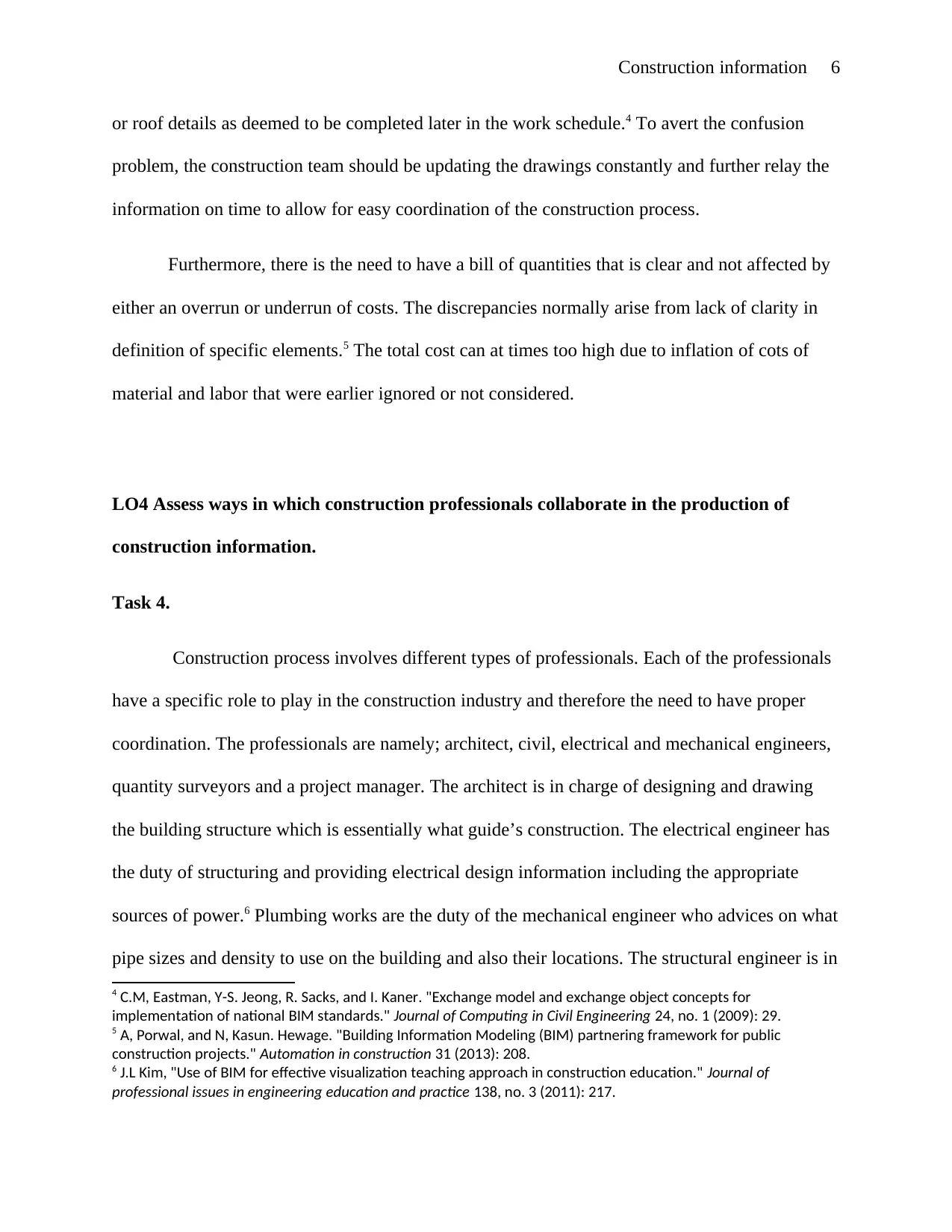
Construction information 6
or roof details as deemed to be completed later in the work schedule.4 To avert the confusion
problem, the construction team should be updating the drawings constantly and further relay the
information on time to allow for easy coordination of the construction process.
Furthermore, there is the need to have a bill of quantities that is clear and not affected by
either an overrun or underrun of costs. The discrepancies normally arise from lack of clarity in
definition of specific elements.5 The total cost can at times too high due to inflation of cots of
material and labor that were earlier ignored or not considered.
LO4 Assess ways in which construction professionals collaborate in the production of
construction information.
Task 4.
Construction process involves different types of professionals. Each of the professionals
have a specific role to play in the construction industry and therefore the need to have proper
coordination. The professionals are namely; architect, civil, electrical and mechanical engineers,
quantity surveyors and a project manager. The architect is in charge of designing and drawing
the building structure which is essentially what guide’s construction. The electrical engineer has
the duty of structuring and providing electrical design information including the appropriate
sources of power.6 Plumbing works are the duty of the mechanical engineer who advices on what
pipe sizes and density to use on the building and also their locations. The structural engineer is in
4 C.M, Eastman, Y-S. Jeong, R. Sacks, and I. Kaner. "Exchange model and exchange object concepts for
implementation of national BIM standards." Journal of Computing in Civil Engineering 24, no. 1 (2009): 29.
5 A, Porwal, and N, Kasun. Hewage. "Building Information Modeling (BIM) partnering framework for public
construction projects." Automation in construction 31 (2013): 208.
6 J.L Kim, "Use of BIM for effective visualization teaching approach in construction education." Journal of
professional issues in engineering education and practice 138, no. 3 (2011): 217.
or roof details as deemed to be completed later in the work schedule.4 To avert the confusion
problem, the construction team should be updating the drawings constantly and further relay the
information on time to allow for easy coordination of the construction process.
Furthermore, there is the need to have a bill of quantities that is clear and not affected by
either an overrun or underrun of costs. The discrepancies normally arise from lack of clarity in
definition of specific elements.5 The total cost can at times too high due to inflation of cots of
material and labor that were earlier ignored or not considered.
LO4 Assess ways in which construction professionals collaborate in the production of
construction information.
Task 4.
Construction process involves different types of professionals. Each of the professionals
have a specific role to play in the construction industry and therefore the need to have proper
coordination. The professionals are namely; architect, civil, electrical and mechanical engineers,
quantity surveyors and a project manager. The architect is in charge of designing and drawing
the building structure which is essentially what guide’s construction. The electrical engineer has
the duty of structuring and providing electrical design information including the appropriate
sources of power.6 Plumbing works are the duty of the mechanical engineer who advices on what
pipe sizes and density to use on the building and also their locations. The structural engineer is in
4 C.M, Eastman, Y-S. Jeong, R. Sacks, and I. Kaner. "Exchange model and exchange object concepts for
implementation of national BIM standards." Journal of Computing in Civil Engineering 24, no. 1 (2009): 29.
5 A, Porwal, and N, Kasun. Hewage. "Building Information Modeling (BIM) partnering framework for public
construction projects." Automation in construction 31 (2013): 208.
6 J.L Kim, "Use of BIM for effective visualization teaching approach in construction education." Journal of
professional issues in engineering education and practice 138, no. 3 (2011): 217.
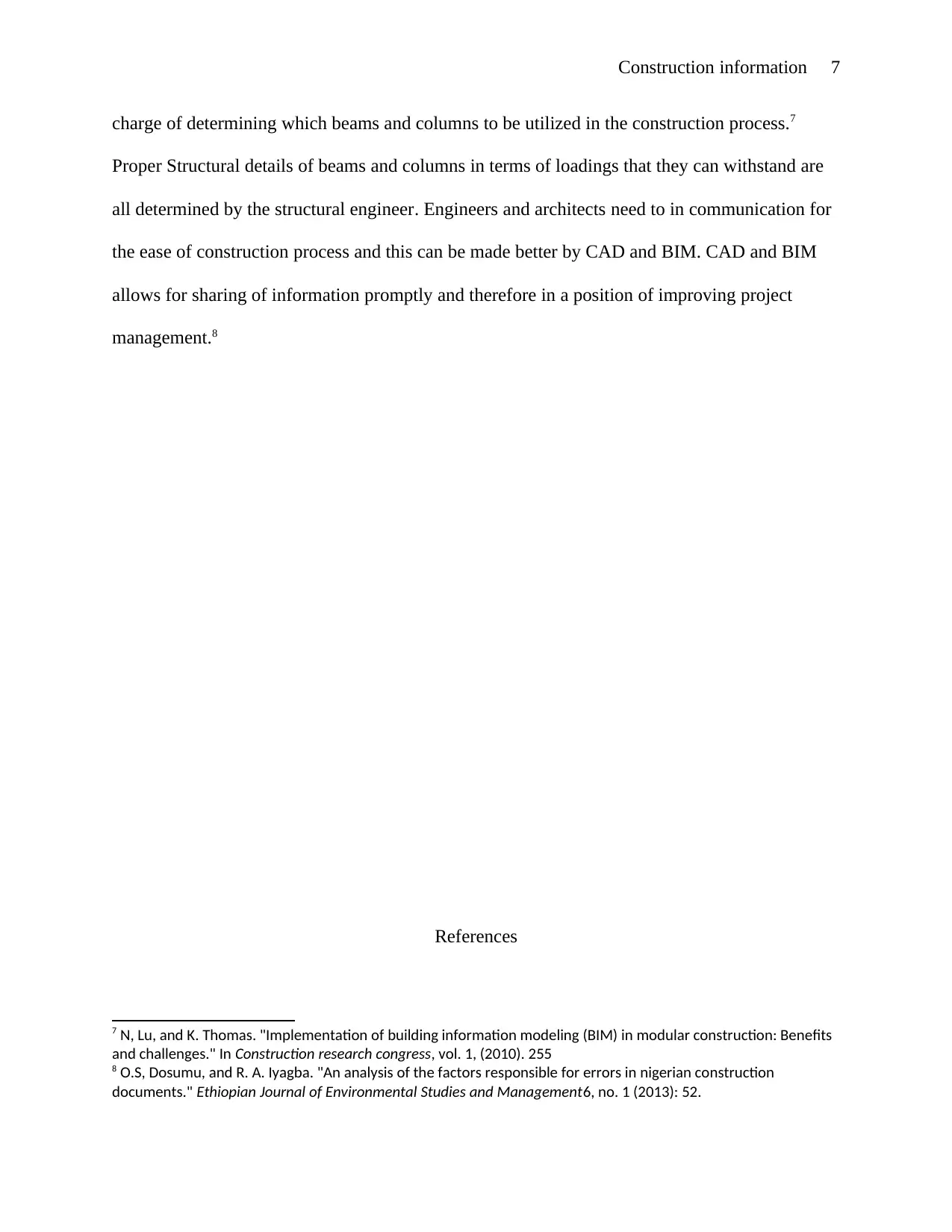
Construction information 7
charge of determining which beams and columns to be utilized in the construction process.7
Proper Structural details of beams and columns in terms of loadings that they can withstand are
all determined by the structural engineer. Engineers and architects need to in communication for
the ease of construction process and this can be made better by CAD and BIM. CAD and BIM
allows for sharing of information promptly and therefore in a position of improving project
management.8
References
7 N, Lu, and K. Thomas. "Implementation of building information modeling (BIM) in modular construction: Benefits
and challenges." In Construction research congress, vol. 1, (2010). 255
8 O.S, Dosumu, and R. A. Iyagba. "An analysis of the factors responsible for errors in nigerian construction
documents." Ethiopian Journal of Environmental Studies and Management6, no. 1 (2013): 52.
charge of determining which beams and columns to be utilized in the construction process.7
Proper Structural details of beams and columns in terms of loadings that they can withstand are
all determined by the structural engineer. Engineers and architects need to in communication for
the ease of construction process and this can be made better by CAD and BIM. CAD and BIM
allows for sharing of information promptly and therefore in a position of improving project
management.8
References
7 N, Lu, and K. Thomas. "Implementation of building information modeling (BIM) in modular construction: Benefits
and challenges." In Construction research congress, vol. 1, (2010). 255
8 O.S, Dosumu, and R. A. Iyagba. "An analysis of the factors responsible for errors in nigerian construction
documents." Ethiopian Journal of Environmental Studies and Management6, no. 1 (2013): 52.
Paraphrase This Document
Need a fresh take? Get an instant paraphrase of this document with our AI Paraphraser
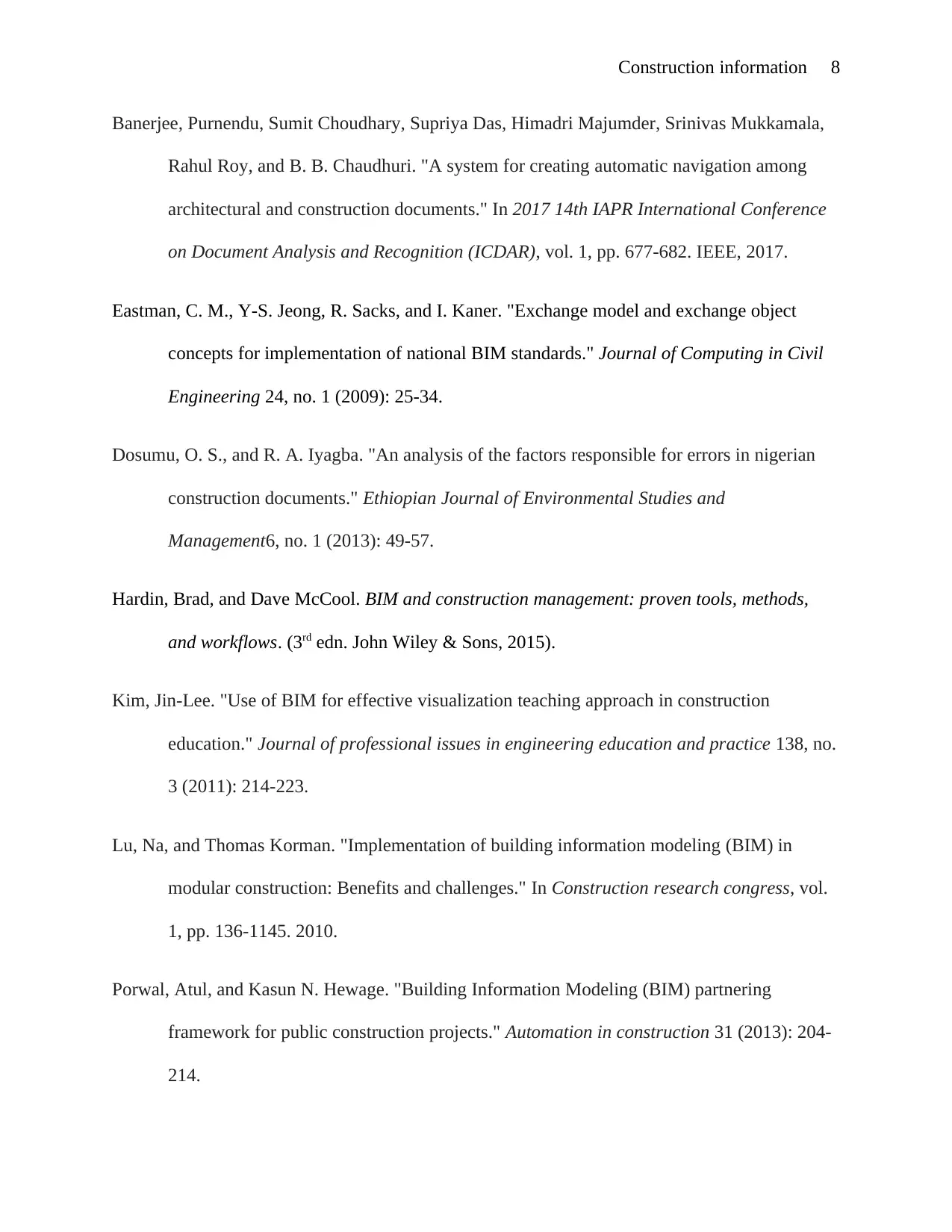
Construction information 8
Banerjee, Purnendu, Sumit Choudhary, Supriya Das, Himadri Majumder, Srinivas Mukkamala,
Rahul Roy, and B. B. Chaudhuri. "A system for creating automatic navigation among
architectural and construction documents." In 2017 14th IAPR International Conference
on Document Analysis and Recognition (ICDAR), vol. 1, pp. 677-682. IEEE, 2017.
Eastman, C. M., Y-S. Jeong, R. Sacks, and I. Kaner. "Exchange model and exchange object
concepts for implementation of national BIM standards." Journal of Computing in Civil
Engineering 24, no. 1 (2009): 25-34.
Dosumu, O. S., and R. A. Iyagba. "An analysis of the factors responsible for errors in nigerian
construction documents." Ethiopian Journal of Environmental Studies and
Management6, no. 1 (2013): 49-57.
Hardin, Brad, and Dave McCool. BIM and construction management: proven tools, methods,
and workflows. (3rd edn. John Wiley & Sons, 2015).
Kim, Jin-Lee. "Use of BIM for effective visualization teaching approach in construction
education." Journal of professional issues in engineering education and practice 138, no.
3 (2011): 214-223.
Lu, Na, and Thomas Korman. "Implementation of building information modeling (BIM) in
modular construction: Benefits and challenges." In Construction research congress, vol.
1, pp. 136-1145. 2010.
Porwal, Atul, and Kasun N. Hewage. "Building Information Modeling (BIM) partnering
framework for public construction projects." Automation in construction 31 (2013): 204-
214.
Banerjee, Purnendu, Sumit Choudhary, Supriya Das, Himadri Majumder, Srinivas Mukkamala,
Rahul Roy, and B. B. Chaudhuri. "A system for creating automatic navigation among
architectural and construction documents." In 2017 14th IAPR International Conference
on Document Analysis and Recognition (ICDAR), vol. 1, pp. 677-682. IEEE, 2017.
Eastman, C. M., Y-S. Jeong, R. Sacks, and I. Kaner. "Exchange model and exchange object
concepts for implementation of national BIM standards." Journal of Computing in Civil
Engineering 24, no. 1 (2009): 25-34.
Dosumu, O. S., and R. A. Iyagba. "An analysis of the factors responsible for errors in nigerian
construction documents." Ethiopian Journal of Environmental Studies and
Management6, no. 1 (2013): 49-57.
Hardin, Brad, and Dave McCool. BIM and construction management: proven tools, methods,
and workflows. (3rd edn. John Wiley & Sons, 2015).
Kim, Jin-Lee. "Use of BIM for effective visualization teaching approach in construction
education." Journal of professional issues in engineering education and practice 138, no.
3 (2011): 214-223.
Lu, Na, and Thomas Korman. "Implementation of building information modeling (BIM) in
modular construction: Benefits and challenges." In Construction research congress, vol.
1, pp. 136-1145. 2010.
Porwal, Atul, and Kasun N. Hewage. "Building Information Modeling (BIM) partnering
framework for public construction projects." Automation in construction 31 (2013): 204-
214.
1 out of 8
Related Documents
Your All-in-One AI-Powered Toolkit for Academic Success.
+13062052269
info@desklib.com
Available 24*7 on WhatsApp / Email
![[object Object]](/_next/static/media/star-bottom.7253800d.svg)
Unlock your academic potential
© 2024 | Zucol Services PVT LTD | All rights reserved.





